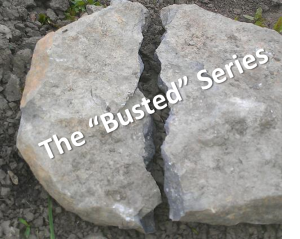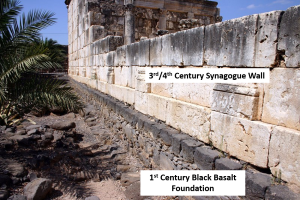Introducing the “Busted” Series
 The gospels, the book of Acts, and other New Testament documents have proven their worth as historically accurate documents over the centuries. Nevertheless, anti-Christian scholars persist in their efforts to paint the gospel writers as liars at worst and careless historians at best. Their assertions that the gospels and Acts are full of contradictions and mistakes are wrong and most often, poorly supported. Most have been debunked repeatedly over the last 150 years. Unfortunately, that hasn’t stopped false assertions from spreading far and wide in today’s world, most often due to the “cut and paste” mentality of many skeptics and the viral nature of the internet.
The gospels, the book of Acts, and other New Testament documents have proven their worth as historically accurate documents over the centuries. Nevertheless, anti-Christian scholars persist in their efforts to paint the gospel writers as liars at worst and careless historians at best. Their assertions that the gospels and Acts are full of contradictions and mistakes are wrong and most often, poorly supported. Most have been debunked repeatedly over the last 150 years. Unfortunately, that hasn’t stopped false assertions from spreading far and wide in today’s world, most often due to the “cut and paste” mentality of many skeptics and the viral nature of the internet.
Over the coming months, we’ll be writing a number of articles for our “Busted” series. In this series, we’ll address head-on the alleged “errors” and “contradictions” in the New Testament that anti-Christian scholars like to repeat. They’ve been busted before, and we’ll bust them again.
The Alleged Error: The Gospels and Acts Mention Synagogues, Which Didn’t Exist In Jesus’ Day
In this article, we take on the “scholarly” assertion that the gospel writers made historical errors when they mentioned synagogues in the New Testament. According to a few skeptical scholars, synagogues did not exist during the Second Temple period of Judaism, which lasted from 515 B.C. until 70 A.D., when the Romans destroyed Jerusalem and the Temple during the First Jewish-Roman War. Remember that Jesus’ ministry took place from about 27-30 A.D.
So, according to some skeptical scholars, the gospel writers must have been writing far after 70 A.D. and made a bush-league error by saying that synagogues existed during Jesus’ time.
To start our exploration of this, let’s take a look at a passage from Luke 7:1-5. This passage mentions the synagogue in Capernaum. This was an important place, because it was a center of Jesus’ activities in Galilee, according to the New Testament:
After he had finished all his sayings in the hearing of the people, he entered Capernaum. Now a centurion had a servant who was sick and at the point of death, who was highly valued by him. When the centurion heard about Jesus, he sent to him elders of the Jews, asking him to come and heal his servant. And when they came to Jesus, they pleaded with him earnestly, saying, “He is worthy to have you do this for him, for he loves our nation, and he is the one who built us our synagogue.”
That passage is but one example, as the word “synagogue” appears more than 50 times in the Gospels and Acts.1 If synagogues didn’t exist during Jesus’ time, then the gospel writers have indeed made a lot of errors.
In his 2003 book, The Incredible Shrinking Son of Man, Robert M. Price writes on p. 14:
“A major collision between the gospel tradition and archaeology concerns the existence of synagogues and Pharisees in pre-70 C.E. Galilee. Historical logic implies that there would not have been any, since Pharisees fled to Galilee only after the fall of Jerusalem.”
Price isn’t the only one making this claim. A few years before Price’s book, professor of New Testament, Howard Clark Kee, published a series of studies arguing that all of the New Testament references to synagogues, as well as references made by the first century Jewish historian, Josephus, were anachronistic and therefore, in error.2
So, do Price and Kee know more about first-century Judaism than did the people who were actually there? Well, no they don’t…not by a long shot. Price and Kee are, in fact, guilty of shockingly bad history.
Actually, Synagogues Did Exist In Jesus’ Day
It’s important to explain that Price and Kee are on the far fringe of scholarly opinion regarding this topic. It has been shown, pretty much conclusively, that synagogues did exist during the time Jesus was conducting his ministry. Nevertheless, I have recently seen repeated on anti-Christian blogs the old and busted claim that synagogues did not exist during that time. It seems that old lies die hard.
Archeologists have discovered nine synagogues that date to the pre-70 era. These discoveries include synagogues at Gamla, the Herodium, Jericho, Magdala, Masada, Modi’in, Qiryat Sefer, Shuafat, and, most importantly, at Capernaum.3
Regarding the Capernaum discovery, a 1983 article in Biblical Archaeology Review (not a Christian publication, by the way) had this to say:
“The first-century Capernaum synagogue in which Jesus preached has probably been found. Because more than one synagogue may have existed in Capernaum at this time, we cannot be sure that this new find was Jesus’ synagogue. But this recently discovered first-century building is certainly a likely candidate…The conclusion that this was a first-century A.D. synagogue seems inescapable.”4
What makes the Capernaum discovery most interesting, is that the first century synagogue was discovered underneath the 3rd or 4th century synagogue that sits on the site today. The current structure rests on a much older black basalt foundation, which has been dated to Jesus’ time.
The old foundation was rather shabbily constructed, and it wasn’t exactly level. Nevertheless, when the first century structure was torn down, the old foundation was retained. In fact, the stonemasons took great care to build the newer structure in such a way as to accommodate the old foundation. Using the old foundation would have been in keeping with the Jewish tradition of building upon a sacred foundation. This lends great weight to the belief that the first century foundation was for a synagogue.5

The synagogue at Capernaum. the light colored wall belongs to the newer, 3rd/4th century synagogue. The dark foundation dates to the 1st century, and likely supported the original synagogue that Jesus visited.
Archeology has told us quite a bit about how synagogues from the pre-70 era were designed and used. A recent (2015) article in Biblical Archaeology Review tells us:
“Synagogues built before and after the destruction of the Jerusalem Temple share many similarities. During both periods, synagogues were communal buildings with benches along the walls. Often, columns divided the main hall into a central space with side aisles. The major architectural difference between the two structures is the Torah Shrine. Whereas the Second Temple-period synagogue at Modi’in lacks this feature”6
…
“The Second Temple-period synagogue at Gamla features stepped benches along its walls and a mikveh (ritual bath) located just south of its entrance.”7
…
“A ritual bath (mikveh) or a water source is often adjunct to the pre-destruction structures, which strengthens their identification as synagogues.”8
…
“The Second Temple-period buildings were used for Torah readings and as a study center. They had a didactic aim and also served as a meeting place for the community.”9
In conclusion, this argument is settled. Synagogues did exist during the time of Jesus. Scholars who say otherwise are wrong, and demonstrably so. There’s no excuse for any historian or scholar making that assertion today, in light of the archeological evidence. The accuracy of the Gospels and Acts remains intact.
Notes:
- Evans, Craig, Jesus and His World: The Archaeological Evidence, Westminster John Knox Press, 2012, Kindle Edition, 1003
- Evans, 1008
- Evans, 1135
- Strange, James F and Shanks, Hershel, “Synagogue Where Jesus Preached Found at Capernaum,” Biblical Archaeology Review, 9 (1983).
- Evans, 1164-1175
- Hachlili, Rachel, “Synagogues Before and After the Roman Destruction of the Temple,” Biblical Archaeology Review, 3 (2015), p. 32
- Hachili, p. 32
- Hachili, p. 33
- Hachili, p. 36-37
